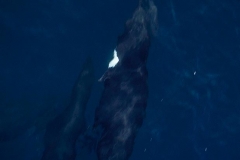


















 Rock Sandpiper and Surfbird at the Ocean Shores Jetty
Rock Sandpiper and Surfbird at the Ocean Shores Jetty
Along with a Westport Seabird Pelagic trip, there are a myriad of other great birding opportunities in Washington State. Fall is the season for lower 48 rarities, like Bar-tailed Godwit and Sharp-tailed Sandpiper, and there can be an early Yellow-billed Loon, Rock Sandpiper, or Gyrfalcon. Spring provides shorebird migration spectacles, and summer offers a tremendous diversity of breeding species from the rain forest inhabitants of the Olympics, alpine tundra breeders in the Cascades and desert shrub steppe specialties in the Columbia Basin.
Spring is the season of migration spectacles, the shorebird passage through Grays Harbor, seabird migration offshore, Sandhill Cranes through the Columbia Basin. Landbird migration can be good too, particularly in the riparian areas and desert oases of eastern Washington. Several bird festivals at this time provide the out-of-town birder with a great introduction to local birding and birders; look for the Othello crane festival and the Grays Harbor shorebird festival on the web.
Summer is the season for finding boreal/montane species such as Boreal Chickadee, Three-toed and Black-backed Woodpeckers, Pine Grosbeak, Sooty, Dusky and Spruce Grouse, and White-tailed Ptarmigan. Good places to look for some or all of these include the North Cascades National Park, Mount Rainier National Park, and the boreal zone of Washington in Okanogan County. Late spring and early summer can be very productive for owling: Saw-whet, Flammulated, Barred, Northern Pygmy and Western Screech can be readily found in the right habitat, and if you are lucky, you have a chance for Great Gray, Spotted or Boreal.
One of the biggest draws of fall birding is shorebird migration, with the possibility of a Ruff, Sharp-tailed Sandpiper or Bar-tailed Godwit. It can also be a great time to bird the high country of Washington, the tundra breeders are still present, and large flocks of passerines are found in the meadows at treeline while hawks migrate overhead.
Winter is mild, and usually wet in Western Washington (cold and snow are always possible east of the Cascade Mountains). Check the hotlines and eBird for recent sighitings of our winter specialities such as Gyrfalcon, Yellow-billed Loon, Ancient Murrelet. In irruption years, Snowy Owls are widely distributed. East of the Cascades, winter is the prime time for finding Snow Buntings, flocks of Gray-crowned Rosy-Finch, Bohemian Waxwings, Gray Partridge, and Sharp-tailed Grouse.
For detailed bird finding information, Westport Seabirds recommends the following guides and checking eBird for the latest local sightings:
A Birder’s Guide to Washington
Jane Hadley
American Birding Association, 2003
Birds of Washington: Status and Distribution
TR Wahl, B. Tweit and S. G. Mlodinow
Oregon State University Press, 2005.
Looking for more Washington State birding sources?
Tweeters Birding E-mail (The Washington State E-mail Listserv)
Washington Ornithological Society (WOS)
All of our trips go offshore to one of three deep water canyons approximately 28-35 miles offshore. These canyons are just beyond the edge of the continental shelf and reach water depths in excess of 2,500 feet.
 Birds that can be expected on most or all April – October trips: Black-footed Albatross, Northern Fulmar, Sooty Shearwater, Pink-footed Shearwater, Fork-tailed Storm-Petrel, Red-necked and Red Ph...
Birds that can be expected on most or all April – October trips: Black-footed Albatross, Northern Fulmar, Sooty Shearwater, Pink-footed Shearwater, Fork-tailed Storm-Petrel, Red-necked and Red Ph...
Copyright © West Port Sea Birds. All Rights Reserved
Questions/Comments about the site? Feel free to e-mail the webmaster







